Biography
 |
 |
 |
 |
 |
 |
 |
Biography of Prof. Plinio Corrêa de Oliveira
A Life Dedicated to Combat
Plinio Corrêa de Oliveira (1908-1995) was born into two traditional Brazilian families, his mother’s family from São Paulo – Ribeiro dos Santos – and his father’s from Pernambuco – Corrêa de Oliveira. The former was known for its social distinction, the latter for its intelligence and oratory skills. Plinio inherited the characteristics of both families.
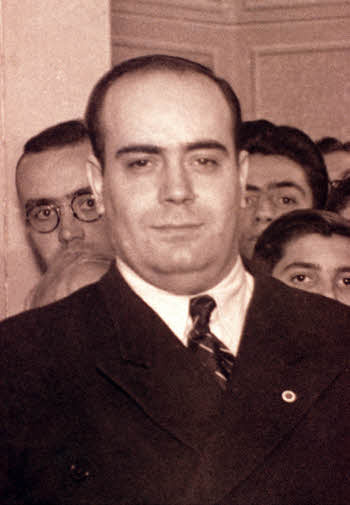 After being formed in the Jesuit school of São Paulo and receiving a degree in Law, he entered the Catholic Movement and became the leader of the Marian Congregations in Brazil. The force of this Movement was such that in 1934 it elected Plinio, at age 24, to the National Congress, making him not only the country’s youngest representative, but also the one who received the most votes. In the House he fought to defend the civil rights of the Church and to pass laws, which for a long time upheld Catholic principles and institutions in the country.
After being formed in the Jesuit school of São Paulo and receiving a degree in Law, he entered the Catholic Movement and became the leader of the Marian Congregations in Brazil. The force of this Movement was such that in 1934 it elected Plinio, at age 24, to the National Congress, making him not only the country’s youngest representative, but also the one who received the most votes. In the House he fought to defend the civil rights of the Church and to pass laws, which for a long time upheld Catholic principles and institutions in the country.
Subsequent to his term in the House, he earned a chair in History of Civilization at the Law Faculty of São Paulo and another in Modern and Contemporary History at the Catholic Pontifical University, also in São Paulo.
In 1933, he was asked by the Cardinal of São Paulo to direct the Archdiocesan weekly journal O Legionário (The Legionary). For many years he was its editor and gathered around him a group of distinguished writers who followed him on a lifetime journey. From a simple Archdiocesan bulletin the paper was transformed in the late ‘30s and ‘40s into the most influential Catholic organ of the country.
The writers of O Legionário became famous for their pugnacious stand against Communism, Nazism and Freemasonry, as well as for defending Christian Civilization and championing a culture coherent with the doctrine of the Catholic Church. In the religious sphere, they combated the nascent Progressivism, which was rising from the ashes of Modernism with the same poison, but new tactics, higher ambitions and a more prudent posturing.
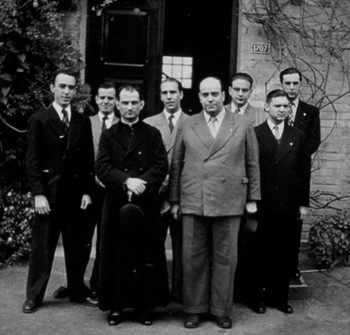 Those writers considered themselves continuers of the ultramontane movement of the 19th century in Europe. Among others, two priests joined the group: Fr. Geraldo Sigaud and Fr. Antônio de Castro Mayer.
Those writers considered themselves continuers of the ultramontane movement of the 19th century in Europe. Among others, two priests joined the group: Fr. Geraldo Sigaud and Fr. Antônio de Castro Mayer.
In 1940, Prof. Plinio was chosen to be president of Catholic Action in São Paulo. From this post, he carefully watched the insidious progressivist infiltration into the religious milieu. By 1943 he fully realized its maneuvers and wrote a book denouncing its strategy – In Defense of the Catholic Action (Em Defesa da Ação Católica). Later he described the launching of that book as a kamikaze operation: he delayed the influence of Progressivism in Brazil, but blew up his own career along with the target.
Indeed, the Cardinal of São Paulo who favored his work died and, after the short term of another, a progressivist took his place in 1944. Prof. Plinio lost the presidency of Catholic Action and the direction of O Legionário. A phase of persecution and ostracism began.
He and the two mentioned priests agreed to continue the Counter-Revolution despite the consequences. Sometime later, Fr. Sigaud was made Bishop, followed by Fr. Castro Mayer. The union of the three was so strong that each Bishop adopted in his coat-of-arms the rampant lion Prof. Plinio had chosen to symbolize his fight.
A new monthly paper, edited and published in São Paulo with the approval of Castro Mayer, now Bishop of Campos, took the name Catolicismo (1951) and recommenced the public fight. The Catolicismo group attracted younger persons, who drew in yet others. With this growing movement, in 1960 he founded the Brazilian Society for the Defense of Tradition, Family and Property – the TFP.
 To provide guidelines for that group, in 1959 Prof. Plinio wrote Revolution and Counter-Revolution – R-CR, which became his masterpiece. In it he analyzed the Revolution’s historical process that started in the Middle Ages. The Renaissance and Humanism were its first manifestations; later it generated Protestantism, the French Revolution and Communism.
To provide guidelines for that group, in 1959 Prof. Plinio wrote Revolution and Counter-Revolution – R-CR, which became his masterpiece. In it he analyzed the Revolution’s historical process that started in the Middle Ages. The Renaissance and Humanism were its first manifestations; later it generated Protestantism, the French Revolution and Communism.
He also described its later phases: namely, the Fourth Revolution (the Cultural Revolution of the ‘60s), which tends toward Tribalism and a Pentecostal religion; the metamorphosis of Communism after the dissolution of the USSR; the infiltration of Progressivism in the Church, which changed the focus of the R-CR fight. Now, it had to be fought inside the Church.
The ideals of R-CR extended to other countries. In 1995, at his death, there were TFPs and similar organizations in 26 countries.
In the early ‘60s, Brazil was threatened by Communism, supported by Progressivism in the Church. Both were proponents of a socialist land reform to destabilize farmers, the backbone of the country's economy. With economist Mendonça de Freitas, Prof. Plinio wrote a book against land reform and invited the Bishops to sign it: Agrarian Reform – a Question of Conscience (1963). A success, the book became the pivot for an enormous public reaction against Communism. An undesired byproduct of this general dissatisfaction was a military coup that deposed the brazenly red president-to-be and installed a socialist dictatorship in the country.
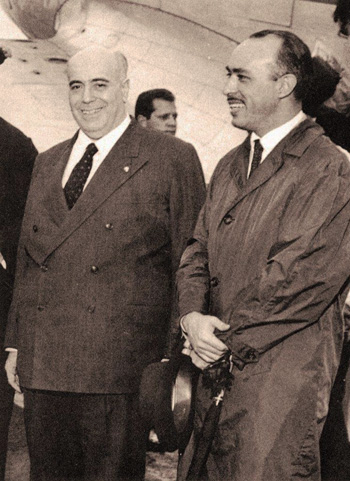 In 1959, John XXIII announced his intention to convene a Council. Prof. Plinio warned Archbishop Sigaud and Bishop Mayer that they should study and prepare themselves intensively or they would be defeated by the progressivists at the Council. Unfortunately, they did not heed his advice.
In 1959, John XXIII announced his intention to convene a Council. Prof. Plinio warned Archbishop Sigaud and Bishop Mayer that they should study and prepare themselves intensively or they would be defeated by the progressivists at the Council. Unfortunately, they did not heed his advice.
Notwithstanding, Prof. Plinio, along with about 20 laymen, accompanied the Bishops to Rome for the First Session with the hope that they would have a positive influence. With these laymen he organized two petitions, signed by hundreds of Bishops: one asking the Council to condemn Communism; the other asking the Pope to consecrate Russia to the Immaculate Heart of Mary as commanded in Fatima.
He sought out the Bishops of Communism-dominated countries asking them to affirm that the Church-Communism coexistence is against Catholic doctrine. Ukrainian Archbishop Ivan Bucko agreed to state this at the Council. Prof. Plinio wrote an intervention for him, but Msgr. Bucko changed his mind and did not address the topic in the Council. In May 1964, Prof. Plinio published that study: The Church and the Communist State: The Impossible Coexistence.
As the first session came to its end, Prof. Plinio realized that the progressivists were in complete control and suggested that the two Brazilian Bishops unmask their maneuvers. He proposed that they solemnly walk from the door of St. Peter’s Basilica to the main table in the conciliar hall, passing by the 2,300 Bishops assembled there. Then, before the whole assembly, they should expose the progressivist agenda for the Council and state that they were leaving in protest. Outside the doors, journalists would be waiting to interview them and spread the news. This dramatic rupture was meant to abort the entire spectacle of Vatican II. Unfortunately, the Bishops did not follow his advice.
He did not return to the Council, which followed that progressivist path until its end.
In 1965, Prof. Plinio wrote a book denouncing the popular new dialogue with communists: Unperceived Ideological Transshipment and Dialogue. Although the approach of the study was temporal, it also applied to the religious dialogue being promoted by John XXIII and Paul VI insofar as dialogue was used not to convert heretics but to make them comfortable in their errors.
After the Council’s closing, he received in Brazil the two returning Bishops. They had signed all its documents and told him, [paraphrasing]: “Now, we need to work on our group so they will accept the Council.” Prof. Plinio opposed the proposition, saying: “Your Excellencies can fry or cook the Council any way you want. I will never eat it.”
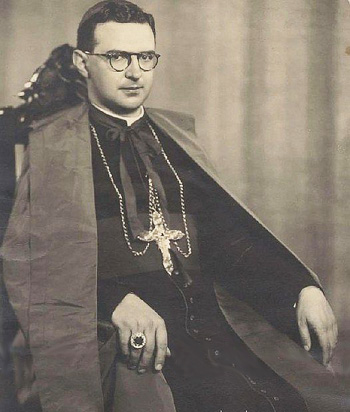 There was no rupture, but this divergence projected shadows on their decades-old relationship.
There was no rupture, but this divergence projected shadows on their decades-old relationship.
Eventually, the two Bishops would break their agreement to stand together in the fight. Some years later Archbishop Sigaud distanced himself. He publicly supported the socialist military regime. His reason? “The military regime started the Reign of Mary predicted in Fatima”…
In the mid ‘70s a lawsuit against the TFP called on Bishop Mayer to testify. He made a sworn statement that throughout more than 40 years of close collaboration he had never seen anything in TFP or in Prof. Plinio’s actions or thoughts that went against Catholic doctrine.
However, in 1983, he took a public stand against Prof. Plinio. Why this change?
In the late ‘70s, a certain Fr. Fernando Rifan – an expert in intrigue – was gaining the ear of Bishop Mayer. Rifan, who hated Prof. Plinio and the TFP, induced the Bishop to soften his position against Progressivism to the point that Bishop Mayer in some talks assumed the principles of John Paul II’s Theology of the Body. In Rome he was photographed holding hands with JPII. Consequently, his visits to São Paulo ceased.
In the early ‘80s, a rancorous high-school teacher, Orlando Fedeli, left the TFP because he felt his talents were not sufficiently recognized. At his rupture he wrote three letters disclosing “evidence” that Prof. Plinio had transformed the TFP into “a cult to worship himself and his mother.” Soon after he left, he sold his story to one of the largest Brazilian newspapers with close ties to Freemasonry – O Estado de São Paulo – which started a boisterous defamatory campaign.
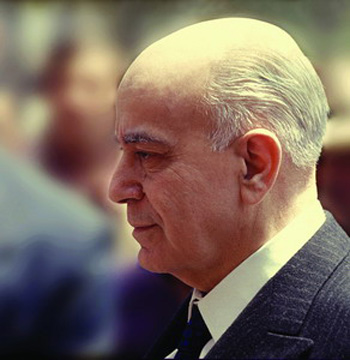 Encouraged by Rifan, Fedeli consulted with Bishop Mayer about a litany that two naïve teenagers had made in honor of Prof. Plinio’s mother. As soon as that litany was discovered, it had been forbidden by Dr. Plinio, but Fedeli did not inform Bishop Mayer of this “detail.” He presented the litany as if it were a prayer commonly said throughout the TFP with Prof. Plinio’s approval. Bishop Mayer condemned the litany as going against Catholic doctrine. This was in 1983.
Encouraged by Rifan, Fedeli consulted with Bishop Mayer about a litany that two naïve teenagers had made in honor of Prof. Plinio’s mother. As soon as that litany was discovered, it had been forbidden by Dr. Plinio, but Fedeli did not inform Bishop Mayer of this “detail.” He presented the litany as if it were a prayer commonly said throughout the TFP with Prof. Plinio’s approval. Bishop Mayer condemned the litany as going against Catholic doctrine. This was in 1983.
This condemnation and Fedeli’s accusations were duly refuted and the documents were reviewed by famous theologians in Spain. They issued a verdict affirming the refutation to be sound and Bishop Mayer’s condemnation “poorly made and difficult to understand.” It judged that some of the litany’s ejaculations were “naïve, others ambiguous and yet others extravagant” and praised Prof. Plinio for having forbidden its recitation. But they considered it “exaggerated to label them as heterodox or blasphemous, not taking into consideration the relative nature of the language being used.” Bishop Mayer judged it prudent not to reply.
The Brazilian TFP published 2,000 copies of that refutation and full-page newspaper ads to inform the public of this judgment favoring Prof. Plinio.
In response, Fedeli went to Spain to try to bribe the principle theologian who made the review. He was duly shown out of the room. Fr. Rifan, who at the time was very close to the Society of St. Pius X, spread the same lies to this organization, which continues to propagate them among its priests and seminarians.
This campaign is just one in a list of many defamatory offensives made against Prof. Plinio.
The Brazilian TFP was also condemned at various times by the very progressivist Brazilian Bishops. Some of these condemnations were duly answered; others not, simply because they were too biased to be credible.
Altogether Prof. Plinio published 15 books.
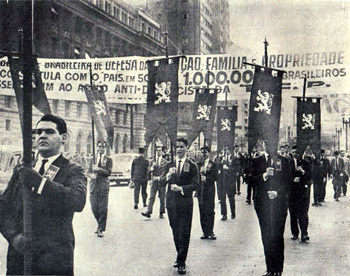 He also spearheaded many petition drives carried out by the TFP including:
He also spearheaded many petition drives carried out by the TFP including:
After Paul VI launched Liberation Theology in Medellin, Colombia (1968), Prof. Plinio made several campaigns against this new thrust of communist infiltration in the Church.
In 1974 he wrote a position of resistance against the Vatican Ostpolitik, that is, its collaboration with the communist regimes. This Declaration of Resistance, which made him the pioneer of Catholic Resistance, was published in 21 newspapers in 10 countries.
In 1982 he asked me to write and publish a collection analyzing Vatican II, which I did under his guidance and encouragement.
Plinio Corrêa de Oliveira was the Catholic giant who, for many decades, held Communism at bay in South America. He also held back the advance of Progressivism in the Church as much as he could.
One aspect that official biographies of this Catholic thinker and man of action do not address is the moral and physical sufferings Prof. Plinio endured.
In the mid ‘70s, seeing how worldly and lukewarm TFP members had become, he offered his life to Our Lady to redeem that situation. Some days later, on February 3, 1975, he was in a serious car accident, suffering a broken hand, arm, leg and hip as well as severe injuries to his eyelids, lips and teeth. These graves lesions demanded multiple surgeries, causing him enormous moral and physical sufferings. The arm, leg and hip surgeries had to be made twice, still without success. The effects of that accident remained with him to the end of his days, obliging him to rely on crutches or a wheelchair.
 This suffering bought 20 more years of life for the TFPs. Toward the end, however, he confided to some friends: “If I were not in a wheelchair, they would expel me from the TFP.” He was referring to the directors who in theory followed his orientation, but in practice moved the TFP to a position of indifference and mediocrity.
This suffering bought 20 more years of life for the TFPs. Toward the end, however, he confided to some friends: “If I were not in a wheelchair, they would expel me from the TFP.” He was referring to the directors who in theory followed his orientation, but in practice moved the TFP to a position of indifference and mediocrity.
When he was dying in the hospital in 1995, those directors lost no time in sending a letter to the Cardinal Primate of Brazil, committing the TFP not to speak publicly against Vatican II, the New Mass or the Pope.
A few years after his death, a split among his followers over the question of authority took place. Today, one faction – which includes the American TFP – upholds that same agreement with the Vatican; the other completely adhered to the Conciliar Church. Many members of the latter became priests and have comfortable ecclesiastical careers.
Sadly, both sides had become weary of the fight against Progressivism, had reduced Prof. Plinio to a museum artifact and merged – in different ways and degrees – with that same enemy against which Prof. Plinio had fought his entire life.

Posted May 6, 2017

When young, Plinio was the leader of the Marian Congregations in Brazil
Subsequent to his term in the House, he earned a chair in History of Civilization at the Law Faculty of São Paulo and another in Modern and Contemporary History at the Catholic Pontifical University, also in São Paulo.
In 1933, he was asked by the Cardinal of São Paulo to direct the Archdiocesan weekly journal O Legionário (The Legionary). For many years he was its editor and gathered around him a group of distinguished writers who followed him on a lifetime journey. From a simple Archdiocesan bulletin the paper was transformed in the late ‘30s and ‘40s into the most influential Catholic organ of the country.
The writers of O Legionário became famous for their pugnacious stand against Communism, Nazism and Freemasonry, as well as for defending Christian Civilization and championing a culture coherent with the doctrine of the Catholic Church. In the religious sphere, they combated the nascent Progressivism, which was rising from the ashes of Modernism with the same poison, but new tactics, higher ambitions and a more prudent posturing.

Fr. Castro Mayer alongside Prof. Plinio and the Legionário team of writers
In 1940, Prof. Plinio was chosen to be president of Catholic Action in São Paulo. From this post, he carefully watched the insidious progressivist infiltration into the religious milieu. By 1943 he fully realized its maneuvers and wrote a book denouncing its strategy – In Defense of the Catholic Action (Em Defesa da Ação Católica). Later he described the launching of that book as a kamikaze operation: he delayed the influence of Progressivism in Brazil, but blew up his own career along with the target.
Indeed, the Cardinal of São Paulo who favored his work died and, after the short term of another, a progressivist took his place in 1944. Prof. Plinio lost the presidency of Catholic Action and the direction of O Legionário. A phase of persecution and ostracism began.
He and the two mentioned priests agreed to continue the Counter-Revolution despite the consequences. Sometime later, Fr. Sigaud was made Bishop, followed by Fr. Castro Mayer. The union of the three was so strong that each Bishop adopted in his coat-of-arms the rampant lion Prof. Plinio had chosen to symbolize his fight.
A new monthly paper, edited and published in São Paulo with the approval of Castro Mayer, now Bishop of Campos, took the name Catolicismo (1951) and recommenced the public fight. The Catolicismo group attracted younger persons, who drew in yet others. With this growing movement, in 1960 he founded the Brazilian Society for the Defense of Tradition, Family and Property – the TFP.

Published in 1959 Revolution and Counter-Revolution became the handbook for the TFPs everywhere
He also described its later phases: namely, the Fourth Revolution (the Cultural Revolution of the ‘60s), which tends toward Tribalism and a Pentecostal religion; the metamorphosis of Communism after the dissolution of the USSR; the infiltration of Progressivism in the Church, which changed the focus of the R-CR fight. Now, it had to be fought inside the Church.
The ideals of R-CR extended to other countries. In 1995, at his death, there were TFPs and similar organizations in 26 countries.
In the early ‘60s, Brazil was threatened by Communism, supported by Progressivism in the Church. Both were proponents of a socialist land reform to destabilize farmers, the backbone of the country's economy. With economist Mendonça de Freitas, Prof. Plinio wrote a book against land reform and invited the Bishops to sign it: Agrarian Reform – a Question of Conscience (1963). A success, the book became the pivot for an enormous public reaction against Communism. An undesired byproduct of this general dissatisfaction was a military coup that deposed the brazenly red president-to-be and installed a socialist dictatorship in the country.

Prof. Plinio leaves Rome when he realizes he has done all he could at the Council
Notwithstanding, Prof. Plinio, along with about 20 laymen, accompanied the Bishops to Rome for the First Session with the hope that they would have a positive influence. With these laymen he organized two petitions, signed by hundreds of Bishops: one asking the Council to condemn Communism; the other asking the Pope to consecrate Russia to the Immaculate Heart of Mary as commanded in Fatima.
He sought out the Bishops of Communism-dominated countries asking them to affirm that the Church-Communism coexistence is against Catholic doctrine. Ukrainian Archbishop Ivan Bucko agreed to state this at the Council. Prof. Plinio wrote an intervention for him, but Msgr. Bucko changed his mind and did not address the topic in the Council. In May 1964, Prof. Plinio published that study: The Church and the Communist State: The Impossible Coexistence.
As the first session came to its end, Prof. Plinio realized that the progressivists were in complete control and suggested that the two Brazilian Bishops unmask their maneuvers. He proposed that they solemnly walk from the door of St. Peter’s Basilica to the main table in the conciliar hall, passing by the 2,300 Bishops assembled there. Then, before the whole assembly, they should expose the progressivist agenda for the Council and state that they were leaving in protest. Outside the doors, journalists would be waiting to interview them and spread the news. This dramatic rupture was meant to abort the entire spectacle of Vatican II. Unfortunately, the Bishops did not follow his advice.
He did not return to the Council, which followed that progressivist path until its end.
In 1965, Prof. Plinio wrote a book denouncing the popular new dialogue with communists: Unperceived Ideological Transshipment and Dialogue. Although the approach of the study was temporal, it also applied to the religious dialogue being promoted by John XXIII and Paul VI insofar as dialogue was used not to convert heretics but to make them comfortable in their errors.
After the Council’s closing, he received in Brazil the two returning Bishops. They had signed all its documents and told him, [paraphrasing]: “Now, we need to work on our group so they will accept the Council.” Prof. Plinio opposed the proposition, saying: “Your Excellencies can fry or cook the Council any way you want. I will never eat it.”

Archbishop Sigaud tries to implement the Council - Prof. Plinio disagrees
Eventually, the two Bishops would break their agreement to stand together in the fight. Some years later Archbishop Sigaud distanced himself. He publicly supported the socialist military regime. His reason? “The military regime started the Reign of Mary predicted in Fatima”…
In the mid ‘70s a lawsuit against the TFP called on Bishop Mayer to testify. He made a sworn statement that throughout more than 40 years of close collaboration he had never seen anything in TFP or in Prof. Plinio’s actions or thoughts that went against Catholic doctrine.
However, in 1983, he took a public stand against Prof. Plinio. Why this change?
In the late ‘70s, a certain Fr. Fernando Rifan – an expert in intrigue – was gaining the ear of Bishop Mayer. Rifan, who hated Prof. Plinio and the TFP, induced the Bishop to soften his position against Progressivism to the point that Bishop Mayer in some talks assumed the principles of John Paul II’s Theology of the Body. In Rome he was photographed holding hands with JPII. Consequently, his visits to São Paulo ceased.
In the early ‘80s, a rancorous high-school teacher, Orlando Fedeli, left the TFP because he felt his talents were not sufficiently recognized. At his rupture he wrote three letters disclosing “evidence” that Prof. Plinio had transformed the TFP into “a cult to worship himself and his mother.” Soon after he left, he sold his story to one of the largest Brazilian newspapers with close ties to Freemasonry – O Estado de São Paulo – which started a boisterous defamatory campaign.

Facing multiple defamatory campaigns with serenity and firmness
This condemnation and Fedeli’s accusations were duly refuted and the documents were reviewed by famous theologians in Spain. They issued a verdict affirming the refutation to be sound and Bishop Mayer’s condemnation “poorly made and difficult to understand.” It judged that some of the litany’s ejaculations were “naïve, others ambiguous and yet others extravagant” and praised Prof. Plinio for having forbidden its recitation. But they considered it “exaggerated to label them as heterodox or blasphemous, not taking into consideration the relative nature of the language being used.” Bishop Mayer judged it prudent not to reply.
The Brazilian TFP published 2,000 copies of that refutation and full-page newspaper ads to inform the public of this judgment favoring Prof. Plinio.
In response, Fedeli went to Spain to try to bribe the principle theologian who made the review. He was duly shown out of the room. Fr. Rifan, who at the time was very close to the Society of St. Pius X, spread the same lies to this organization, which continues to propagate them among its priests and seminarians.
This campaign is just one in a list of many defamatory offensives made against Prof. Plinio.
The Brazilian TFP was also condemned at various times by the very progressivist Brazilian Bishops. Some of these condemnations were duly answered; others not, simply because they were too biased to be credible.
Altogether Prof. Plinio published 15 books.

A TFP street campaign celebrating the defeat of divorce
- A petition against divorce in Brazil, 1966, 1 million signatures;
- A request to Paul VI to stop the communist infiltration in the Church, 1968, 2 million signatures total in Brazil, Argentina, Chile and Uruguay.
- An entreaty for the liberation and independence of Lithuania, 1990, 5.2 million signatures.
After Paul VI launched Liberation Theology in Medellin, Colombia (1968), Prof. Plinio made several campaigns against this new thrust of communist infiltration in the Church.
In 1974 he wrote a position of resistance against the Vatican Ostpolitik, that is, its collaboration with the communist regimes. This Declaration of Resistance, which made him the pioneer of Catholic Resistance, was published in 21 newspapers in 10 countries.
In 1982 he asked me to write and publish a collection analyzing Vatican II, which I did under his guidance and encouragement.
Plinio Corrêa de Oliveira was the Catholic giant who, for many decades, held Communism at bay in South America. He also held back the advance of Progressivism in the Church as much as he could.
One aspect that official biographies of this Catholic thinker and man of action do not address is the moral and physical sufferings Prof. Plinio endured.
In the mid ‘70s, seeing how worldly and lukewarm TFP members had become, he offered his life to Our Lady to redeem that situation. Some days later, on February 3, 1975, he was in a serious car accident, suffering a broken hand, arm, leg and hip as well as severe injuries to his eyelids, lips and teeth. These graves lesions demanded multiple surgeries, causing him enormous moral and physical sufferings. The arm, leg and hip surgeries had to be made twice, still without success. The effects of that accident remained with him to the end of his days, obliging him to rely on crutches or a wheelchair.

A tragic car accident that won more
20 years of fight for the TFPs
When he was dying in the hospital in 1995, those directors lost no time in sending a letter to the Cardinal Primate of Brazil, committing the TFP not to speak publicly against Vatican II, the New Mass or the Pope.
A few years after his death, a split among his followers over the question of authority took place. Today, one faction – which includes the American TFP – upholds that same agreement with the Vatican; the other completely adhered to the Conciliar Church. Many members of the latter became priests and have comfortable ecclesiastical careers.
Sadly, both sides had become weary of the fight against Progressivism, had reduced Prof. Plinio to a museum artifact and merged – in different ways and degrees – with that same enemy against which Prof. Plinio had fought his entire life.

With his symbol the rampant lion
Posted May 6, 2017
______________________
 Volume I |
 Volume II |
 Volume III |
 Volume IV |
 Volume V |
 Volume VI |
 Volume VII |
 Volume VIII |
 Volume IX |
 Volume X |
 Volume XI |
 Special Edition |